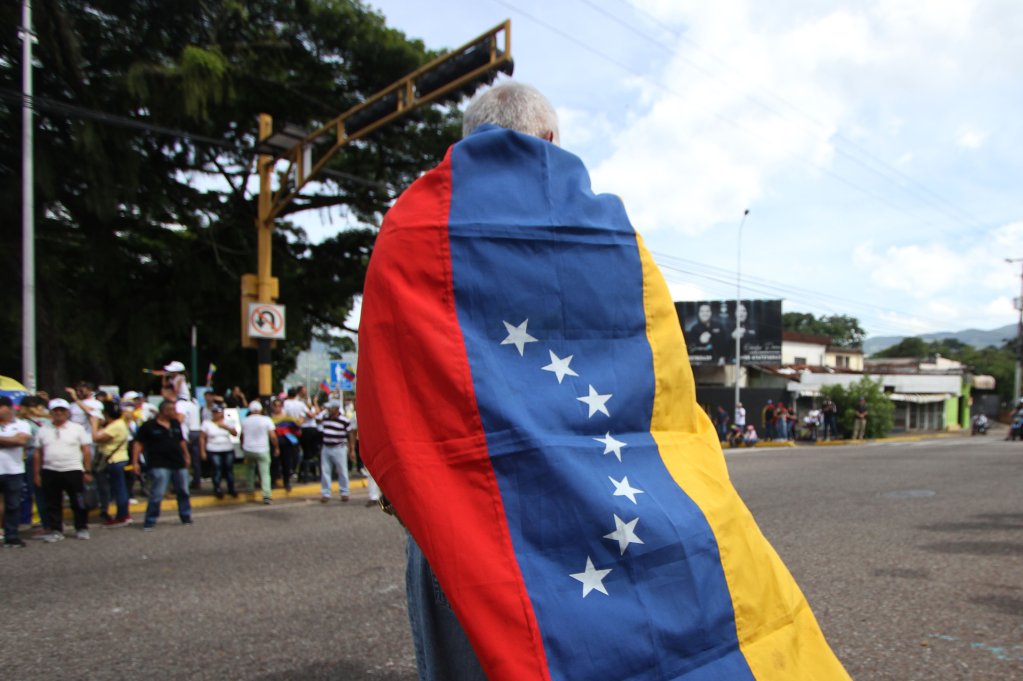Fears over a mass exodus are growing as Venezuela spirals further into political and economic chaos. Venezuelans-in-exile in the Canary Islands are calling on Spain to immediately speed up the process of obtaining residence and work permits for immigrants from Venezuela without the need to request asylum.
The Canary Islands-based Venezuela Solidarity Association (La Asociacion Solidaridad Venezuela) has described the current situation in Venezuela as akin to "a state of war," urging Spanish authorities to expedite the issuance of residence and work permits for Venezuelan immigrants without requiring them to seek asylum.
Security forces in Venezuela launched a crackdown on opposition voices in the aftermath of Venezuela's disputed July 28 presidential election.
At least 16 people were killed in clashes and riots across the country, while forces loyal to President Nicolas Maduro also rounded up over 2,000 people for protesting against the leader.
Venezuelan opposition leader Maria Corina Machado has warned of a "migration wave" if Maduro clings onto power by force.

Latin Americans lead Spain's asylum applications
Spain reports receiving large numbers of asylum seeker applications from Latin American applicant groups -- including by people from Venezuela, Colombia, Peru, Cuba and Honduras, according to the European Union Agency for Asylum (EUAA).
Venezuelans and Colombians now rank as the fourth and fifth largest groups of asylum seekers in the EU, respectively, following Syria, Afghanistan, and Turkey, while Peruvians ranked 10th, according to the International Organization for Migration (IOM).
Most enter the bloc by flying to Europe and then overstaying their visitors' permits or claiming asylum. This is increasingly seen as the safest migration option by many Latin Americans, as migrating to the United States is becoming increasingly difficult.
More arrivals from Venezuela in 2024
Approximately 400,000 people born in Venezuela currently live in Spain, with a significant presence in the Canary Islands and Madrid.
Citing Spanish official statistics, Venezuelans were among the top three nationalities arriving in Spain's Canary Islands between April and June this year, and they ranked as the largest nationality among new arrivals to the city of Santa Cruz de Tenerife, the Spanish news agency EFE reported.
According to Spain's National Institute of Statistics (Instituto Nacional de Estadística), 44,000 Venezuelans arrived in Spain during the first half of the year alone, averaging 241 arrivals per day, or 1,692 per week.
This marks an increase of 7% in arrival numbers of Venezuelan citizens compared to the previous year.
But it is not only to Spain where Venezuelans and other Latin Americans are headed.

Top EU countries of asylum for Latin Americans in 2023 (source: IOM 2024)
• Venezuelans: Spain, Germany, Iceland, Italy
• Colombians: Spain, Germany, Italy, France
• Peruvians: Spain, Italy, France, Germany
• Cubans: Spain, Germany, Italy, France
• Hondurans: Spain, Italy, Germany
While most Latin Americans evidently prefer Spain over other EU countries, Italy is also among the preferred destinations; Germany and France are also increasingly becoming attractive choices to many who wish to flee persecution, violence, crime, corruption, economic instability, and the impacts of climate change.
Gema Maria Cortes, a spokeswoman from the IOM Office of the Special Envoy for the Venezuela Regional Response, told InfoMigrants that family networks, language, existence of sizeable communities of migrants already in Europe "may explain the distribution of Latin American nationals across Europe with a preference for Spain and Italy, where also citizenship acquisition may be facilitated for descendants of prior Spanish and Italian immigrants from Latin America and the Caribbean (LAC)."
EUAA spokesman Andrew McKinlay told InfoMigrants that Spain is "by far the member state receiving the most applications from these two groups."
McKinlay added that the new EU migration trend that emerged since last year -- in addition to the rise in numbers of Venezuelans -- concerns Peruvians: "While relatively low in absolute terms, the around 23,000 applications lodged by Peruvians in 2023 is near double the 2022 figure (12,840) and almost four times the number of applications lodged in 2020 (6,160)."
Migration routes different from other groups
"Given the geographical distance between the countries of origin and the EU+... the EUAA assumes that applicants arrive by plane," McKinlay told InfoMigrants.
The majority of Latin American countries have such visa-free agreements with the EU, which means that their nationals can fly regularly to Europe and then apply for asylum.
Under EU law, anyone can apply for international protection once they enter a member state, irrespective of how they arrive.
This mean that Venezuelans, Colombians and Peruvians -- the top three nationalities seeking asylum in Europe -- get to enjoy visa-free access to the EU under Regulation (EU) 2018/1806 for up to 90 days in any 180-day period during which they can lodge their asylum application.
A good alternative is for migrants and refugees to be able to directly apply to regular pathways from Latin America, the IOM spokeswoman told InfoMigrants, citing the existing Safe Mobility Office (SMO) in Costa Rica for Nicaraguan nationals who go to Spain as an example.
"This model could be replicated with relevant nationalities in Latin America and many receiving countries in Europe and facilitate migration processes benefiting both the applicants and the EU countries," she stressed.
Low acceptance rates for Latin American asylum seekers in Europe
However, Latin American asylum applications have, in fact, very low recognition rates.
"Until the end September 2023, the quarterly EU+ recognition rate for Colombians was 5 % on average; in the case of Peruvians, it was 4 % and finally, for Venezuelans it stood at around 2 %," McKinley from the EUAA pointed out.
Even in Spain, almost all first instance decisions on these applications were rejected during this period.
"These data do not, however, paint a complete picture. Indeed, when national humanitarian admission schemes are factored in, the 'effective protection rate' increases significantly," he added.

Skewed narratives on migration linked to racism
Despite being the fourth and fifth largest nationalities by the number of asylum requests, Venezuelan, Colombian and other Latin American immigrants to Europe are often overlooked in much of the present migration reporting and political discourse.
Most of the attention currently zooms in instead on sub-Saharan migrants, despite their smaller absolute numbers.
Similarly, stories about land and sea crossings and calls for bolstering border and sea patrols in Europe dominate many tabloids, with less attention given to topics like visa overstays and protection rates of Latin Americans.
InfoMigrants asked Claire Healy from the Vienna-based UNODC Observatory on Smuggling of Migrants for her thoughts on what she believes might be behind this phenomenon:
"In Europe as a whole, and it's the same in the US for example, the vast majority of undocumented migrants simply overstay their tourist visa. But there's this imagery, this idea of an 'invasion,' which I do not subscribe to. It's all nonsense," Healy told InfoMigrants.
"I'm very much against all of the racist interpretations of it, it's quite artificial. It's the imagery of boats or of people arriving on the US-Mexican border. Those are not the main numbers. In fact, in comparison to population, they're tiny numbers," she stressed further.
